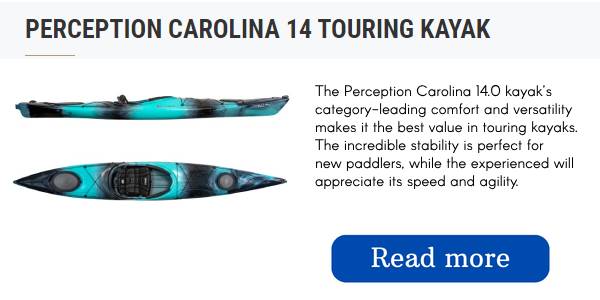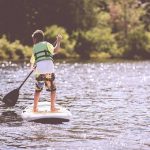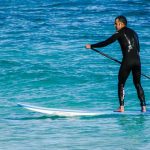One of the reasons I took to paddle boarding many years ago was its versatility.
I mean, from paddle boarding you can go to SUP surfing, to yoga, and all these other activities on your board that you will never get tired of.
We’re going to talk about paddle surfing, the different types of surfboards, and all the things you might be wondering about them. So stick around if you’re curious about SUP surfing.
What is SUP Surfing?
If you have experience with regular paddle boarding, you may want to try SUP surfing to mix things up and learn new skills. However, you will realize that surfing waves on a SUP is very different from flat water SUPing.
While it is not significantly tricky, you will have to learn some new moves and techniques to get rolling.
You don’t need to worry if you have already been on a SUP board and have paddled through calm and choppy waters. You have a great foundation and will quickly learn to SUP surf!
I’m going to explain the basics of paddle surfing through the next 8 main tips.
SUP Surfing: The Main Gear
The SUP Surfing Board
The most important piece of equipment for SUP surfing is the SUP surfboard.
If you’re still happy with it and feel like you can get good waves on it, then you don’t need to get a new one. However, if you feel like you’re missing out on something or feel like you need an upgrade, then maybe it’s time to get a new board.
If you’re still happy with your current SUP board and feel like you can get good waves on it, then you don’t need to get a new one. However, if you feel like you’re missing out on something or feel like you need an upgrade, then maybe it’s time to get a new board.
You need to be able to float and maneuver your SUP board to balance and ride waves on it. A longer SUP board will be slower to turn in the surf, and a board that is quite wide will hold less in the hollower waves.
However, experienced surfers will still be able to SUP surf, but beginners might have a more difficult time mastering it all.
Shortly said, this is the length you are going to need for SUP surfing:
This will increase the maneuverability of your board A smaller SUP board will be more maneuverable than a larger one. If you have been using a 10-12 ft board for cruising or touring, you will need a 9 ft board for SUP surfing.
If you have been using a 9-10 ft board, then an 8ft board would be perfect for paddle boarding.
And this is the width of the SUP board needed for smooth SUP surfing:
Choose a board that is 30 or 31 inches wide if you want to paddle board surf.
When it comes to the design, surf sups should have a surfboard-type shape instead of a canoe or floater. It should look like an oversized short or longboard surfboard.
Choose a SUP board that is not too heavy and that you can carry by the handle from the car to the water without having to put it down for a rest.
As you are just starting, worry more about board length rather than width. A board that is too short will not work unless you are already a seasoned paddler or surfer. However, after you try SUP surfing for the first couple of weeks, you will be hooked.
If you are planning on using your SUP board for SUP surfing, it might be a good idea to get a cheaper or used board. Beginner’s boards can be outgrown quickly and you’ll soon be ready for a board that provides more maneuverability and control.
The SUP Surfing Paddle
When it comes to SUP surfing, you cannot just get away with any SUP paddle. You need a special paddle that is not too heavy and is made from plastic and/or metal.
When paddle boarding, you will want a board that is lightweight. This will help you move easier through the waves and make quick turns. If a wave is coming towards you, you can push your paddle away quickly.
I would advise you to invest in a full-carbon SUP paddle because it will be a bit pricier than your usual paddle, BUT you will use it for years in SUP surfing and paddle boarding, and it won’t tire your arms, so it’s a win-win situation!
If you are strapped for cash, you can always find a good deal on used items.
When it comes to paddle boarding, you want the board to be several centimeters taller than you, but for paddle board surfing, you need the board to be the same height as you.
The SUP Surfing Leash
The last important piece of equipment for paddle surfing is the board leash.
The type of board you use for paddle boarding or SUP surfing also makes a difference in the type of leash you need. A surf SUP board is usually bulkier and heavier than a stand-up paddle board, so you will need a longer, thicker leash.
This is because you are surfing waves, and your leash is more likely to pull hard on your leg and board as your board is constantly swept away by the waves.
The leash you use should be as long as your board, but not so long that it gets tangled around your feet.
Coiled leashes are not recommended for SUP surfing as they can be dangerous due to the recoil and extended length in the waves.
A thicker leash is better for heavier SUP surfing and stronger waves.
Is Paddleboarding Easier Than Surfing?
There is a belief that faster vessels are more stable and therefore easier to operate. However, many different factors need to be considered when operating a vessel in water. Read on to find the basic answer, as well as some factors that may impact stability.
Paddle boarding does not require as much balance, coordination, and reactive skills as surfing. Surfing also requires the ability to read waves so that you can position yourself correctly to catch them.
I found that it is harder to catch a wave while surfing than it is to ride the wave, and it is even harder to surf for any extended period of time.
I was able to pick up paddleboarding quickly because I was on flat water on a calm day–all I had to do was stand up and slowly paddle. However, paddleboarding down white-water rapids is going to be much harder than basic surfing.
So, where does it end? What is the real answer? This article provides a detailed comparison of the two sports so that you can have a better understanding of your question.
Surfing vs Paddling
Paddling and surfing are two very different activities. You can do many different things with a SUP, whereas with a surfboard you can only do one thing, albeit with many different variations.
Things to do on your Stand-Up Paddleboard
- Gentle paddling on calm seas, lakes, streams, and canals
- Yoga
- Fishing
- Medium paddling on rivers, big lakes, and calm seas
- Surfing smaller beach waves
- Hard paddling in rapids, windy conditions, or the sea
- Navigating waterfalls and river white-waters
- Surfing big waves
- Paddleboard racing
- Windsurfing
- SUP Air Guitaring (OK I made that last one up, or did I?)
There are many ways to exercise your dog, including taking them on a paddleboard. The main selling point for the paddleboard hobby is its versatility. It would be difficult to make a complete list of all the activities you can do with a paddleboard.
There are different levels of difficulty when it comes to surfing. For example, riding broken waves with a big foam longboard is relatively easy, while riding offshore waves is extremely difficult and only for experienced surfers.
Obviously, it is easier to surf when the waves are smaller and closer to shore. The same goes for paddle boarding. It is much easier to paddle board in calm water close to shore than it is to try to ride a huge wave miles away from land.
If you want to try stand-up paddleboarding, start by paddling on still water in calm conditions. This is easier than trying to stand up on a surfboard in the waves.
The simple answer is that paddle boarding is easier than surfing.
A surfer would probably disagree with this. Surfing is about catching an unbroken wave and going down it. It might be harder at first, but it gets easier. Especially if you get advice on where to surf and what equipment to use.
Some paddle boarders might protest that a gentle paddle in easy conditions is nice and a good core workout, but there is no adrenaline in it. Also, nothing to catch on your Go-Pro to impress your friends with.
Now that we have that in mind, let’s look more closely at the two hobbies and the problems they present.
Surfboard vs Paddleboard
Surfing boards are designed to be ridden in the waves, while SUPing boards are designed to be ridden flatwater. A surfing board is generally shorter and has a pointed nose and tail, while a SUPing board is often longer and has a more rounded nose and tail.
The difference in design means that surfing boards are more maneuverable, while SUPing boards are more stable. To get a better understanding of the skill required for each sport, we can start by looking at the boards.
Surfing boards are designed to be ridden in waves, while SUPing boards are designed to be ridden on flatwater. Surfing boards are generally shorter and have a pointed nose and tail, while SUPing boards are often longer and have a more rounded nose and tail.
The difference in design means that surfing boards are more maneuverable, while SUPing boards require more skill to balance on.
Some boards are good for touring, others are good for surfing, and some are good for both. paddleboards come in many sizes and shapes. There are also different types of hulls.
Some boards are good for touring, others are good for surfing, and some are good for both.
Types of SUP hulls
- Inflatable
- Fiberglass
- Rigid plastic
Some inflatable stand-up paddleboards are good for surfing, but most are designed for calmer waters. The inflatable is more common for river paddling because it will take less damage in rapids and white waters. Generally, the fiberglass SUP is faster than the other types.
Most surfboards are smaller and narrower than paddleboards. People who are new to surfing will usually start out on longboards that are up to 9 feet long. The boards that beginners use can be made from foam, but most people who surf regularly use boards that are made from fiberglass.
There are even some surfboards that are made from wood. The classic longboard from the 1960s was made from wood, but there are also some traditional Hawaiian boards that are made from wood, like the Alanya.
Other than the main body, paddleboards can come in different varieties. Some, made for Yoga, might have a soft traction pad that covers the entire board. Others, made for fishing, might have mesh netting on the sides to protect against damage from hooks.
The surfboard has several different types. The key difference is how they behave in different waves. The different types of surfboards are made to act differently in order to give the rider a better experience.
Some surfboard types
- Fish (Looks like a fish)
- The Gun (For riding really big waves)
- Funboard (A beginner to an intermediate board)
Different surfboards have different shapes depending on the desired purpose. For example, the tail might be round or pointed, the nose might be blunt or sharp, and the rails might be thin or thick.
There is a board for every type of wave, so choosing the right one is essential for a good surfing experience.
The key differences between the two types of board:
- Size
- Buoyancy
A surfboard’s ability to float depends on its capacity to displace water. A paddleboard will float with the entire rider out of the water, so it needs to be large enough to support that weight but also relatively light.
A surfboard will only float when it is moving quickly; when a rider is not paddling, a surfboard will sink if it is not large enough.
A paddleboard is a stable and reliable craft, while a surfboard is not.




